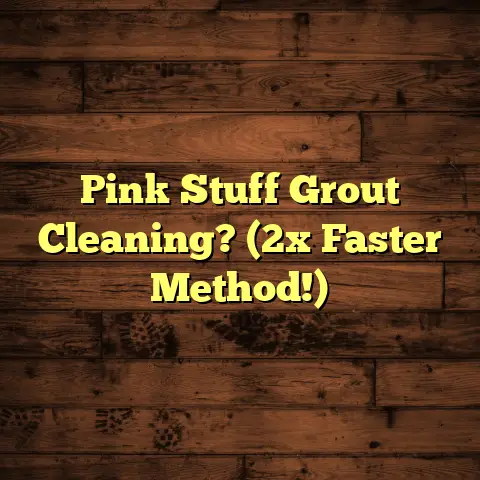Acid For Tile Cleaning: Which Type Is Best? (DIY Fail)
As winter loosens its grip and spring breathes new life,
I notice a familiar urge in homeowners: the spring
cleaning frenzy!
After months of being cooped up,
everyone’s itching to refresh their living spaces.
And what’s usually at the top of that list?
Tile flooring.
It’s seen it all – muddy boots,
holiday spills, and everything in between.
As the days get longer, the desire for sparkling
tiles becomes almost… primal!
But here’s the thing: in their eagerness, many DIYers
jump straight to acidic cleaners, thinking they’re the
magic bullet.
I’ve seen it time and time again – and
trust me, it doesn’t always end well.
Why?
Because without understanding the nuances,
you can easily end up causing more harm than good.
We’re talking etching, discoloration, and even
permanent damage.
That’s why I’m writing this – to guide you through the
world of acid-based tile cleaning, so you can make
informed decisions and avoid those dreaded DIY fails.
Let’s dive in!
1. Understanding Tile Flooring
Before we even think about acids, let’s get the basics
down.
Not all tiles are created equal, and what works
for one might be disastrous for another.
1.1. Overview of Tile Types
Ceramic vs.
Porcelain: These are your workhorses.
Ceramic is more porous, making it slightly more susceptible to staining.
Porcelain is denser, more durable, and water-resistant.
I often recommend porcelain for high-traffic areas.Natural Stone Tiles (Marble, Granite, etc.): Ah, the beauties!
Marble is soft and porous, while granite is harder and more resistant.
But both are sensitive to acids.
I can’t stress this enough: never use strong acids on natural stone.Vinyl and Linoleum Tiles: These are resilient flooring options.
Vinyl is synthetic, while linoleum is made from natural materials.
They’re generally acid-resistant, but harsh chemicals can still damage their finish.
1.2. Common Tile Issues
Stains and Discoloration: Coffee spills, pet accidents, hard water – they all leave their mark.
The type of stain dictates the best cleaning approach.Mold and Mildew Buildup: Damp areas like bathrooms and kitchens are breeding grounds.
Proper ventilation is key to prevention.Grout Deterioration: Grout is porous and prone to staining and cracking.
Regular sealing is a must!
I tell my clients that grout is the Achilles’ heel of any tile installation.
2. The Role of Acids in Cleaning Tiles
Okay, now for the main event: acids.
But what exactly
are they, and why do people use them for cleaning?
2.1. What Are Acidic Cleaners?
Definition and Properties: Acids are substances with a pH less than 7.
They have the ability to dissolve mineral deposits, rust, and other stubborn buildup.
Think of them as tiny demolition crews, breaking down the grime on your tiles.How They Work on Stains and Buildup: Acids work by reacting with the stain or buildup, breaking it down into smaller, more soluble particles that can be easily rinsed away.
This chemical reaction is what makes them so effective.
2.2. Types of Acids Commonly Used
Here’s a rundown of the acids you’re most likely to encounter in the world of tile cleaning:
Hydrochloric Acid (Muriatic Acid): This is the heavy hitter.
It’s incredibly effective at removing tough stains and mineral deposits, but it’s also highly corrosive.
I only recommend it for specific situations and always with extreme caution.Phosphoric Acid: A bit milder than hydrochloric acid, but still potent.
It’s often used in rust removers and bathroom cleaners.Citric Acid: This is the eco-friendly option.
Derived from citrus fruits, it’s a gentler acid that’s effective on mineral deposits and hard water stains.Acetic Acid (Vinegar): The DIY staple!
Vinegar is a weak acid that’s readily available and relatively safe.
However, it’s not a miracle worker, and it can damage certain surfaces.Oxalic Acid: This is particularly effective at removing rust stains and tannin stains (like those from leaves or wood).
It’s also used to brighten wood.
However, it’s toxic and requires careful handling.
2.3. pH Levels and Safety
Explanation of pH and Its Importance in Cleaning: pH is a measure of acidity or alkalinity.
The pH scale ranges from 0 to 14, with 7 being neutral.
Acids have a pH less than 7, and the lower the pH, the stronger the acid.Substance pH (Approximate) Hydrochloric Acid 0-1 Phosphoric Acid 1-2 Citric Acid 2-3 Acetic Acid (Vinegar) 2-3 Oxalic Acid 1-2 Water 7 Safety Precautions When Handling Acidic Cleaners: This is non-negotiable!
Always wear:- Gloves: Acid-resistant gloves are a must.
- Eye Protection: Goggles or a face shield.
- Ventilation: Work in a well-ventilated area.
- Protective Clothing: Cover your skin to avoid splashes.
Never mix acids with other chemicals, especially bleach. This can create toxic fumes.
Always read and follow the manufacturer’s instructions.
And if you’re unsure about something, err on the side of caution and call a professional.
3. Evaluating Acid Cleaning Options
Now, let’s get down to the nitty-gritty. Which acid is best for which situation?
3.1. Hydrochloric Acid (Muriatic Acid)
Effectiveness on Tough Stains: This is the big gun.
It can dissolve stubborn mineral deposits, efflorescence (that white, powdery stuff on tile), and heavy rust stains.Potential Damage to Surfaces: It can etch and discolor tile, especially natural stone.
It can also damage metal fixtures and grout.Recommended Dilution Ratios for Safe Use: Always dilute hydrochloric acid with water.
A common starting point is a 1:10 ratio (1 part acid to 10 parts water), but always test in an inconspicuous area first.
Always add acid to water, never the other way around, to avoid dangerous splattering.
3.2. Phosphoric Acid
Common Applications and Effectiveness: Often found in bathroom cleaners and rust removers.
It’s effective on hard water stains, soap scum, and rust.Safety Measures to Consider: Wear gloves, eye protection, and work in a well-ventilated area.
Avoid contact with skin and eyes.Comparison with Hydrochloric Acid: Phosphoric acid is less corrosive than hydrochloric acid, making it a slightly safer option for some applications.
However, it’s still a strong acid and should be used with caution.
3.3. Citric Acid
Eco-Friendly Option for Tile Cleaning: This is a great choice if you’re looking for a more natural cleaning solution.
It’s biodegradable and less harmful to the environment.-
Effectiveness on Mineral Deposits: Citric acid is effective at dissolving mineral deposits, hard water stains, and soap scum.
-
Limitations Compared to Stronger Acids: It’s not as powerful as hydrochloric or phosphoric acid, so it may not be effective on very stubborn stains.
3.4. Acetic Acid (Vinegar)
Popular DIY Solution: Pros and Cons: Vinegar is cheap, readily available, and relatively safe.
It’s a good option for light cleaning and maintenance.-
Effectiveness on Various Tile Types: It can be used on ceramic and porcelain tile, but it’s not recommended for natural stone.
Risks of Using Vinegar on Natural Stone: Vinegar can etch and dull the surface of natural stone, especially marble.
I’ve seen homeowners ruin beautiful marble floors with vinegar.
3.5. Oxalic Acid
Best Uses and Effectiveness: Oxalic acid is a powerful stain remover, particularly effective for rust stains, tannin stains (like those from leaves or wood), and ink stains.
It’s also used to brighten wood.Safety Concerns and Handling Instructions: Oxalic acid is toxic if ingested or inhaled.
Always wear gloves, eye protection, and a respirator when using it.
Work in a well-ventilated area.
Keep it out of reach of children and pets.-
Comparing Its Effectiveness to Other Acids: While it’s not as versatile as some other acids, its ability to remove specific types of stains makes it invaluable in certain situations.
4. Common DIY Cleaning Mistakes
This is where I share some hard-earned wisdom.
I’ve
seen so many well-intentioned DIYers make these
mistakes, and I want to help you avoid them.
4.1. Overuse of Acidic Cleaners
-
Consequences of Excessive Use: Etching, discoloration, damage to grout, and weakening of the tile surface.
Real-Life Examples of DIY Fails: I once had a client who used undiluted hydrochloric acid to clean their porcelain tile.
The result?
The tile was permanently discolored and had a rough, etched surface.
They had to replace the entire floor.
4.2. Incorrect Dilution and Application
Importance of Following Guidelines: Dilution ratios are there for a reason.
Too much acid can cause damage, while too little may not be effective.Case Studies of Improper Application: Another client sprayed vinegar directly onto their marble countertop and left it to soak.
When they wiped it off, they were left with dull, etched patches.
4.3. Neglecting Safety Precautions
-
Common Injuries and Accidents: Chemical burns, eye irritation, respiratory problems from inhaling fumes.
-
Importance of Protective Gear: Gloves, eye protection, ventilation – these are not optional!
4.4. Failing to Test Surfaces
The Necessity of Spot Testing: Always test the cleaner in an inconspicuous area before applying it to the entire surface.
This will allow you to see how the tile reacts and avoid any surprises.Success Stories vs.
Horror Stories: I had a client who was about to use hydrochloric acid on their natural stone floor.
Fortunately, they decided to test it in a corner first.
The acid immediately etched the stone, and they realized they had dodged a bullet.
5. Alternatives to Acidic Cleaners
Okay, so acids can be risky. What are some safer alternatives?
5.1. Non-Acidic Cleaning Solutions
-
Overview of Effective Alternatives:
- Alkaline Cleaners: These are effective at removing grease, oil, and organic stains.
- Enzyme Cleaners: These break down organic matter like food spills and pet accidents.
- Steam Cleaning: This uses hot steam to loosen dirt and grime without chemicals.
-
Eco-Friendly Options That Are Safe for All Tile Types:
- Baking Soda: A mild abrasive that can be used to scrub away stains.
- Castile Soap: A gentle, plant-based soap that’s safe for most surfaces.
- Hydrogen Peroxide: A mild disinfectant that can be used to remove stains and kill mold.
5.2. Professional Cleaning Services
-
When to Consider Hiring a Pro:
- When you’re dealing with stubborn stains that you can’t remove yourself.
- When you’re unsure about which cleaning products to use.
- When you want to avoid the risk of damaging your tile.
-
Potential Benefits of Professional Cleaning:
- Expertise and experience.
- Access to professional-grade equipment and cleaning solutions.
- Peace of mind knowing that the job will be done correctly and safely.
5.3. Regular Maintenance Strategies
-
Preventative Measures to Avoid Heavy Cleaning:
- Sweep or vacuum regularly to remove dirt and debris.
- Wipe up spills immediately.
- Use doormats to trap dirt before it enters your home.
-
Importance of Routine Care for Tile Longevity:
- Regular cleaning and sealing can help to protect your tile and keep it looking its best for years to come.
Conclusion: The Importance of Informed Choices
As spring cleaning season rolls around, remember that
knowledge is power.
Acidic cleaners can be effective,
but they’re not a one-size-fits-all solution.
Understanding the different types of acids, their
potential risks, and safer alternatives is crucial for
achieving a successful cleaning experience without
damaging your tile.
By making informed choices, you can enjoy sparkling
tiles without falling victim to those common DIY fails.
And if you’re ever in doubt, don’t hesitate to call a
professional.
Happy cleaning!





